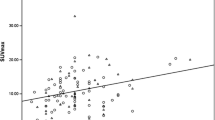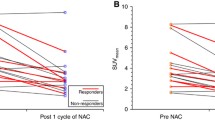Abstract
Purpose
2-Deoxy-2-[F-18]fluoro-D-glucose (FDG) uptake may be a useful surrogate marker for proliferation index, but the correlation has not always been clear-cut. Previous research by our group suggests that FDG-positron emission tomography (PET) is sensitive in detecting triple negative breast cancer. We therefore performed a pilot study to test if FDG uptake correlated with proliferation index in women with triple negative cancer.
Procedures
To determine whether proliferation index correlates with metabolic uptake of FDG in women with triple negative breast cancer, we performed a retrospective analysis correlating %Ki67 nuclear stain with tumor maximum standardized uptake values (SUVmax) in a group of 41 women, 22 with triple negative and 19 with non-triple negative breast cancer.
Results
As expected, [18F]-PET imaging was significantly more sensitive in detecting triple negative breast cancer than non-triple negative breast cancer, 95.5% vs 68.4% (p = 0.036). In general, SUVmax and %Ki67 nuclear stain values rise as histologic grade worsens. Histologic grade of triple negative breast cancer was more often poorly differentiated than non-triple negative cancer (p = 0.001). SUVmax correlated with %Ki67 nuclear staining in our entire cohort (spearman correlation = 0.485, p = 0.002). Moreover, this significant correlation appeared to be driven primarily by a subset of women with triple negative cancer (spearman correlation = 0.497, p = 0.019).
Conclusions
Degree of tumor FDG uptake correlated significantly with proliferation index in women with triple negative breast cancer suggesting a potential role of FDG-PET in treatment response monitoring for this group of women. Future studies are necessary to define the role of PET imaging as a non-invasive means to monitor breast cancer treatment response in the neoadjuvant setting.



Similar content being viewed by others

References
Dowsett M, Smith IE, Ebbs SR, Dixon JM, Skene A, A’Hern R, Salter J, Detre S, Hills M, Walsh G (2007) Prognostic value of Ki67 expression after short-term presurgical endocrine therapy for primary breast cancer. J Natl Cancer Inst 99(2):167–170
Dowsett M, Smith IE, Ebbs SR, Dixon JM, Skene A, Griffith C, Boeddinghaus I, Salter J, Detre S, Hills M et al (2006) Proliferation and apoptosis as markers of benefit in neoadjuvant endocrine therapy of breast cancer. Clin Cancer Res 12(3 Pt 2):1024s–1030s
von Minckwitz G, Kummel S, Vogel P, Hanusch C, Eidtmann H, Hilfrich J, Gerber B, Huober J, Costa SD, Jackisch C et al (2008) Neoadjuvant vinorelbine-capecitabine versus docetaxel-doxorubicin-cyclophosphamide in early nonresponsive breast cancer: phase III randomized GeparTrio trial. J Natl Cancer Inst 100(8):542–551
Rastogi P, Anderson SJ, Bear HD, Geyer CE, Kahlenberg MS, Robidoux A, Margolese RG, Hoehn JL, Vogel VG, Dakhil SR et al (2008) Preoperative chemotherapy: updates of National Surgical Adjuvant Breast and Bowel Project Protocols B-18 and B-27. J Clin Oncol 26(5):778–785
Avril N, Rose CA, Schelling M, Dose J, Kuhn W, Bense S, Weber W, Ziegler S, Graeff H, Schwaiger M (2000) Breast imaging with positron emission tomography and fluorine-18 fluorodeoxyglucose: use and limitations. J Clin Oncol 18(20):3495–3502
Shimoda W, Hayashi M, Murakami K, Oyama T, Sunagawa M (2007) The relationship between FDG uptake in PET scans and biological behavior in breast cancer. Breast Cancer 14(3):260–268
Higashi K, Clavo AC, Wahl RL (1993) In vitro assessment of 2-fluoro-2-deoxy-D-glucose, L-methionine and thymidine as agents to monitor the early response of a human adenocarcinoma cell line to radiotherapy. J Nucl Med 34(5):773–779
Basu S, Chen W, Tchou J, Mavi A, Cermik T, Czerniecki B, Schnall M, Alavi A (2008) Comparison of triple-negative and estrogen receptor-positive/progesterone receptor-positive/HER2-negative breast carcinoma using quantitative fluorine-18 fluorodeoxyglucose/positron emission tomography imaging parameters: a potentially useful method for disease characterization. Cancer 112(5):995–1000
Rakha EA, Reis-Filho JS, Ellis IO (2008) Basal-like breast cancer: a critical review. J Clin Oncol 26(15):2568–2581
Tchou J, Wang LP, Sargen M, Sonnad S, Tomaszewski J, Schnall M (2006) Do triple-negative breast cancers have a distinct imaging phenotype? Breast Cancer Res Treat 100(Supplement 1):S128
Perou CM, Sorlie T, Eisen MB, van de Rijn M, Jeffrey SS, Rees CA, Pollack JR, Ross DT, Johnsen H, Akslen LA et al (2000) Molecular portraits of human breast tumours. Nature 406(6797):747–752
Sorlie T, Perou CM, Tibshirani R, Aas T, Geisler S, Johnsen H, Hastie T, Eisen MB, van de Rijn M, Jeffrey SS et al (2001) Gene expression patterns of breast carcinomas distinguish tumor subclasses with clinical implications. Proc Natl Acad Sci USA 98(19):10869–10874
Wahl RL, Zasadny K, Helvie M, Hutchins GD, Weber B, Cody R (1993) Metabolic monitoring of breast cancer chemohormonotherapy using positron emission tomography: initial evaluation. J Clin Oncol 11(11):2101–2111
Jansson T, Westlin JE, Ahlstrom H, Lilja A, Langstrom B, Bergh J (1995) Positron emission tomography studies in patients with locally advanced and/or metastatic breast cancer: a method for early therapy evaluation? J Clin Oncol 13(6):1470–1477
Schelling M, Avril N, Nahrig J, Kuhn W, Romer W, Sattler D, Werner M, Dose J, Janicke F, Graeff H et al (2000) Positron emission tomography using [(18)F]Fluorodeoxyglucose for monitoring primary chemotherapy in breast cancer. J Clin Oncol 18(8):1689–1695
Dose Schwarz J, Bader M, Jenicke L, Hemminger G, Janicke F, Avril N (2005) Early prediction of response to chemotherapy in metastatic breast cancer using sequential 18F-FDG PET. J Nucl Med 46(7):1144–1150
Rousseau C, Devillers A, Sagan C, Ferrer L, Bridji B, Campion L, Ricaud M, Bourbouloux E, Doutriaux I, Clouet M et al (2006) Monitoring of early response to neoadjuvant chemotherapy in stage II and III breast cancer by [18F]fluorodeoxyglucose positron emission tomography. J Clin Oncol 24(34):5366–5372
Schwarz-Dose J, Untch M, Tiling R, Sassen S, Mahner S, Kahlert S, Harbeck N, Lebeau A, Brenner W, Schwaiger M et al (2009) Monitoring primary systemic therapy of large and locally advanced breast cancer by using sequential positron emission tomography imaging with [18F]fluorodeoxyglucose. J Clin Oncol 27(4):535–541
Gasparini G, Dal Fior S, Pozza F, Bevilacqua P (1989) Correlation of growth fraction by Ki-67 immunohistochemistry with histologic factors and hormone receptors in operable breast carcinoma. Breast Cancer Res Treat 14(3):329–336
Acknowledgement
We thank Dr. Paul Zhang for interpreting immunohistochemistry analyses of ER, PR, and Her2/neu.
Competing interests
The authors declare that they have no competing interests.
Author information
Authors and Affiliations
Corresponding authors
Additional information
Grant Support
This study is supported, in part, by the American College of Surgeons Faculty Research Fellowship, Commonwealth Tobacco Funds (Health Research Formula Fund), and Grant #IRG-78-002-26 from the American Cancer Society (JT), and by a grant P01CA85424 (MS). This study was presented in part at the 30th Annual San Antonio Breast Cancer Symposium, December 13–16, 2007.
Rights and permissions
About this article
Cite this article
Tchou, J., Sonnad, S.S., Bergey, M.R. et al. Degree of Tumor FDG Uptake Correlates with Proliferation Index in Triple Negative Breast Cancer. Mol Imaging Biol 12, 657–662 (2010). https://doi.org/10.1007/s11307-009-0294-0
Received:
Revised:
Accepted:
Published:
Issue Date:
DOI: https://doi.org/10.1007/s11307-009-0294-0



